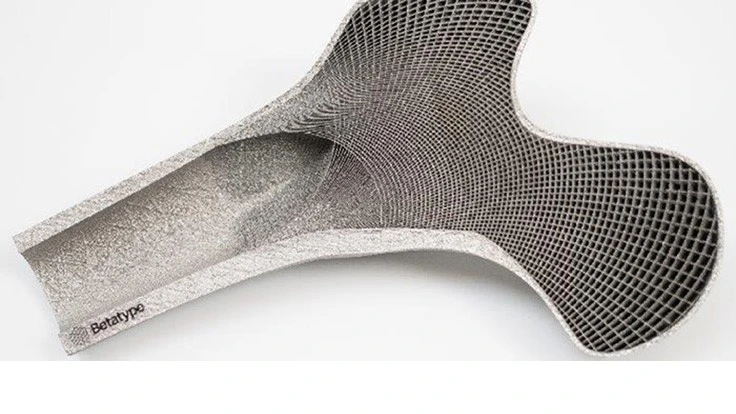
West Dundee, Illinois – Renishaw attended the American Academy of Orthopedic Surgeons (AAOS) Annual Meeting held in New Orleans, Louisiana, and exhibited a range of prototype orthopedic implants additively manufactured (3D printed) in titanium on Renishaw’s healthcare-optimized additive manufacturing (AM) systems.
Dr. Jonathan Jeffers of Imperial College London, UK, presented data from an ongoing project, funded by the UK government and Renishaw, investigating the development of load bearing lattice structures for orthopedic implants. By incorporating a lattice, implants can provide a scaffold structure for new bone tissue to grow into. The spacing and strut thickness of the lattice can be optimized to match the stiffness of the surrounding bone. It may be possible to create a strain gradient on the bone, which can accelerate growth.
 “The partnership between Imperial College London and Renishaw is creating really exciting data on new materials that can control the way bone repairs itself,” Jeffers comments. “These materials could change the way orthopedic implants are designed in the future, and certainly provide an opportunity to improve patient outcomes by repairing the musculoskeletal system with materials that can invoke a desired response in bone.”
“The partnership between Imperial College London and Renishaw is creating really exciting data on new materials that can control the way bone repairs itself,” Jeffers comments. “These materials could change the way orthopedic implants are designed in the future, and certainly provide an opportunity to improve patient outcomes by repairing the musculoskeletal system with materials that can invoke a desired response in bone.”
Betatype, a London-based company and a technical collaborator in the research project, is providing its expertise in design, engineering, and material science. Betatype’s deep understanding of manufacturing technologies helps to optimize the complexity in part production to deliver the optimum balance in terms of features, quality, and production speed for AM applications.
Ahead of the AAOS Meeting, Betatype founder Sarat Babu commented: “On display at the show will be a portfolio of additive manufacturing builds to showcase what can be achieved on the Renishaw platform with Betatype capability. The builds include lattice structures which are more complex, in terms of resolution and density, than anything that can usually be achieved using traditional manufacturing techniques.”
Renishaw’s additive manufacturing systems produce implants using a process known as laser powder bed fusion (LPBF). During the process, lasers are used to melt metal powder in layers as thin as 30µm. As the powder melts a solid product is formed. This method allows complex, customized designs to be manufactured quickly and with little waste.
Latest from Today's Medical Developments
- Siemens accelerates path toward AI-driven industries through innovation and partnerships
- REGO-FIX’s ForceMaster and powRgrip product lines
- Roundup of some news hires around the manufacturing industry
- Mazak’s INTEGREX j-Series NEO Machines
- The Association for Advancing Automation (A3) releases vision for a U.S. national robotics strategy
- Mitutoyo America’s SJ-220 Surftest
- #56 - Manufacturing Matters - How Robotics and Automation are Transforming Manufacturing
- STUDER looks back on a solid 2024 financial year






